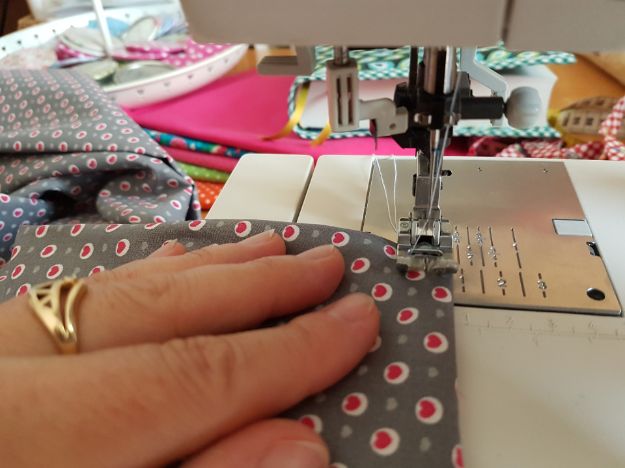Something you'll realize when working with slippery fabric is that unlike most other fabrics, it is quite difficult to sew. If you're looking for smart ways to make working with it easier, we've got you covered. Stick around to learn these simple tips and tricks!
How To Sew with Slippery Fabrics
Normally, when we're working with simple fabric, we simply must lay it out on our work table and sew away. However, when working with slippery fabrics, we need to go an extra step to guarantee the quality of our fabric. This tutorial can help you learn how to master sewing with difficult fabrics:
Materials:
- tissue paper / paper
- silk thread
- silk organza
- tape
Tools:
- silk pins
- sharp sewing needles
- micro-serrated scissors
- sewing machine
- iron
Instructions:
1. Prepare Your Fabric
Two Options:
#1: Lay your fabric on your table and secure it with tape, then take your silk or lightweight slippery fabric, and lay it on top of your tissue paper. Cut out everything in one layer, making it sure that the edges of both fabric and tissue are all aligned. Cut your fabric in a single layer. Make sure that your salvages are neat so that the fabric is sitting straight and in line with the edge of your paper.
No products found.
#2: With paper on the bottom, and your fabric on top, lay down tissue paper and put your silk fabric on top of it to create a sandwich. Match up the edge of this tissue paper with the edge of the fabric and the previous tissue paper and lay it all together. The layer of tissue paper helps keep your fabric flat and will prevent your slippery or silk fabric from moving.
2. Lay Down Your Pattern Piece
Lay your pattern pieces as you normally do with your fabric. Measure from the grain line to the salvage and check to make sure your pattern piece is straight.
3. Pin Your Silk Fabrics
Pin your tissue paper and silk using silk pins. Use the silk pins that are the same to avoid making damaging the fabric. Pin your fabric in seam allowances or close to the edge of the fabric, because if the pin will damage the fabric, it should be in the seam allowance and not at the center of the garment.
4. Cut Your Fabric
Once you've pinned your pattern piece onto the layers of your tissue paper and silk, you'll be cutting through it to get a lovely smooth cut and your fabric won't be slip anywhere. Use a silk thread because it smoothly glides with the fabric.
5. Sewing Your Slippery Fabric
When working with your silk or slippy fabric, you'll have to use a walking foot.
No products found.
Needles:
You need to work with a smaller needle. The lighter your fabric is, the smaller the size of the needle required. When working with any difficult fabric, test your fabric with your presser foot. It would be a wise idea to make some practice to ensure that everything is functioning properly. If you're working with a lightweight fabric, you need to move to a 75 11 size needle or a 65 10 size. To prevent puckered fabric, avoid blunt or large needles.
Presser Foot:
Use a walking foot if you're working with any difficult fabric such as a silk or any other slippery fabric. It has feed dogs at the bottom that help pull difficult fabrics through.
Stitches:
When sewing with lighter fabrics, you need to have a smaller stitch. The standard stitch is 2.5 millimeters, but you may want to work with 1.5 to 2 millimeters for lightweight fabrics. Don't use a back stitch or a fixing stitch. Simply tie or knot threads at the start and at the end of your sewing. For a lightweight fabric, you should use a french seam. For hemming, it is advisable to make a rolled hem with your sewing machine or a rolled hem by hand.
If you don't have a walking foot, or you're having problems with your lightweight fabric, you can use a fabric stabilizer or a piece of tissue paper placed at the bottom depending on where you're having a problem. The purpose of using tissue paper or a fabric stabilizer is to help you begin sewing. Once you're finished, you simply have to tear the material away.
If you're having problems with your sewing machine, such the fabric being pulled into the hole of your machine bed, replace the throat plate with one that has smaller holes. You may need to change the pressure of the presser foot when using a thin fabric. Increasing the pressure makes it a breeze for your machine to pull the fabric through.
6. Ironing Your Silk Or Slippery Fabric
If you're working with 100% silk, then your fabric can take quite a lot of heat. However, you must be cautious of the steam because silk can be stained by moisture.
Pressing is recommended after sewing, whether you're working with silk or any other kind of fabric to get a professional finish. Use a layer of silk organza as your pressing cloth when working with silk or any other lightweight fabric.
- Width: 58/60"
- Content: 47% Polyester, 53% Rayon
- Weight: 595 g/m
Watch this video tutorial about Sewing Using Silk Or Slippy Fabrics by Anicka from Made To Sew:
Now you can be confident to tackle projects involving slippery fabrics and increase your sewing skills.
Do you know of any other tips and tricks for sewing difficult fabric? Let us know in the comments below!
